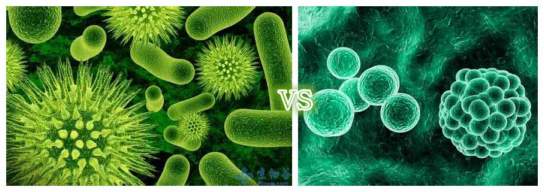Bacteria and viruses are often lumped into a general category of ‘things that can make people sick’. But although they can both cause illness, they are very different agents of infection.
All viruses are full time ‘bad guys’; parasites which require a living host in order to reproduce. In contrast, bacteria are living cells, and some are actually ‘good guys’; normal flora that inhabit the human body and help a person stay in good health. Still, the pathogenic, or ‘bad guy’, bacteria generally get more attention, since, like viruses, they are able to make people sick. The following is a comparison of the basic similarities and differences between acellular (viral) and prokaryotic (bacteria) microbes.

* Bacterial Cell Structure *
The Inside of the Bacterial Cell: Bacteria are living unicellular organisms, much smaller and simpler than the eukaryotic cells that make up the human body. Like all cells, bacteria have double-stranded DNA as their genome. The genome is a tangled mass of naked DNA called a nucleiod, which, like all internal bacteria structures is suspended in the cytoplasm of the cell along with all other internal structures. Some bacteria also have additional ‘bonus’ genetic material, called a plasmid, which contains genes that aid in bacterial virulence, the ability to cause disease.
The interiors of most bacterial cells are essentially the same; the genome (genetic blueprint), granules (food), ribosomes (protein-production organelle) and the plasma membrane – a phospholipid bilayer in which channel and recognition proteins transverse and are suspended.
The Outside of the Bacterial Cell: From the plasma membrane outward, the world of bacteria split in two, based on the structure of the bacterial cell wall. Gram-positive cell walls are simply composed of multiple layers of peptidoglycan, whereas Gram-negative cells have a single layer of peptodidoglycan attached to a lipopolysaccharide membrane. These differences in cell wall structure are clinically important, in that they impact the effectiveness of antibiotics with a mode of action (MOA) that targets cell wall structure.
Beyond the cell wall, some bacteria may have an additional layer to their cell envelope, a glycocalyx that plays a role in bacterial virulence (the capsule) or a bacterium’s resistance to desiccation (the slime layer).
You can also see the characteristics of bacteria here.
* The Structure of a Virus *
Viruses are ‘bare bones’ infectious agents, lacking even the basic cellular machinery of prokaryotic cells. A virus is composed of at least genetic material (DNA or RNA) and a protein capsid protecting the genetic material and allowing unenveloped viruses to recognize the host. Some viruses also have a phospholipid envelope, stolen from the host cell upon exit.
Viruses don’t do much of anything for themselves, beyond infecting a living cell. Once that is accomplished, the viral genome instructs the host cell to produce more viruses. The cell must provide the materials and the energy required to multiply its virus.
* Sources *
Bauman, R. (2005) Microbiology. Pearson Benjamin Cummings.
Park Talaro, K. (2008) Foundations in Microbiology. McGraw Hill.

